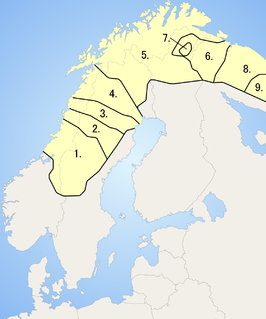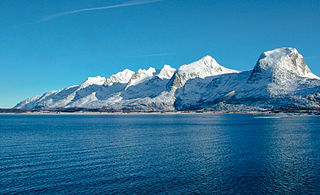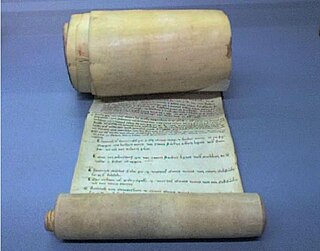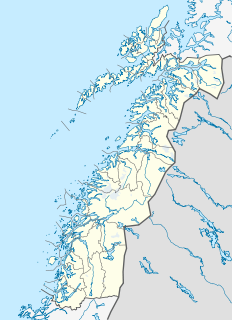
The Sulitjelma Glacier is one of the largest glaciers in mainland Norway. The 24-square-kilometre (9.3 sq mi) glacier is located in mostly in Norway, but the eastern part crosses over into Sweden. The Norwegian part is in Fauske Municipality in Nordland county, about 40 kilometres (25 mi) east of the town of Fauske. The Swedish part lies on the border of Arjeplog Municipality and Jokkmokk Municipality in Norrbotten County. When the whole glacier is considered, it is the largest glacier in Sweden.

Kjelvatnet (Norwegian) or Giebbnejávrre or Giebnejávri (Lule Sami) is a lake in Fauske Municipality in Nordland county, Norway. The 3.85-square-kilometre (1.49 sq mi) lake lies about 7 kilometres (4.3 mi) south of the village of Sulitjelma near the border with Junkerdal National Park. Water flows into the lake from the large lake Balvatnet and it flows out of the lake to the north along the Balmi River to the lake Langvatnet.

Låmivatnet or Loamevatnet (Norwegian) or Loamejávrre (Lule Sami) is a lake in Fauske Municipality in Nordland county, Norway. The 11.43-square-kilometre (4.41 sq mi) lake lies about 5 kilometres (3.1 mi) east of the village of Sulitjelma, just south of the Sulitjelma Glacier and north of Junkerdal National Park. The border with Sweden is 3 kilometres (1.9 mi) east of the lake. The Lomi Hydroelectric Power Station uses the lake as a reservoir.

Muorkkejávrre (Lule Sami) or Eidevatnet or Eidvatnet (Norwegian) is a lake that lies in Fauske Municipality in Nordland county, Norway. The 5.94-square-kilometre (2.29 sq mi) lake lies about 75 metres (246 ft) west of the border with Sweden and about 10 kilometres (6.2 mi) east of the village of Sulitjelma. The water from the lake flows west into the neighboring lake Låmivatnet. The ending -jávrre is the Lule Sami word for "lake".

Venset is a village in the municipality of Fauske in Nordland county, Norway. Venset lies on the north shore of Skjerstad Fjord about 17 kilometers (11 mi) west of the town of Fauske and about 6 kilometres (3.7 mi) south of the village of Valnesfjord.

Sulitjelma is a mountain massif on the Norway-Sweden border in the municipality of Fauske in Nordland, Norway and the municipality of Arjeplog in Norrbotten, Sweden. The massif lies east of the village of Sulitjelma, which takes its name from the mountain. The massif is bordered by Låmivatnet and Muorkkejávrre to the south, and by Bajep Sårjåsjávrre and Vuolep Sårjåsjávrre to the north. About two-thirds of the mountain is in Norway. The Langvann Valley extends toward the massif along a northwest-southeast axis, through which the Sjønstå River flows, forming the Sulitjelma watercourse. The valley starts at the village of Sjønstå on Øvervatnet, which lies about 17 kilometers (11 mi) east of the village of Sulitjelma itself.

The Sjønstå River is a river in the municipality of Fauske in Nordland county, Norway. The river is located in the valley between the town of Fauske and the village of Sulitjelma.

Sjønstå is a settlement in Norway and was officially a village during a brief time when Sulitjelma Mines carried out activity in the area, c. 1890 to 1956. Before this time, Sjønstå comprised the Sjønstå farm, which is located on Øvervatnet in the municipality of Fauske in Nordland county.

Fossen is a waterfall along the Sjønstå River in Nordland county, Norway. It is about 9 kilometers (5.6 mi) upriver from the Sjønstå farm in the municipality of Fauske.

The Lomi Hydroelectric Power Station is a hydroelectric power station in the municipality of Fauske in Nordland county, Norway. It utilizes a drop of 580 meters (1,900 ft) between its intake reservoir on Låmivatnet, which can be regulated at a level between 708 m (2,323 ft) and 649 m (2,129 ft). The reservoir is supplied by water from Storelvvatnan, a lake regulated at a level between 798 m (2,618 ft) and 792 m (2,598 ft), and also by some stream intakes. Part of the water supplying the plant is runoff from the Sulitjelma Glacier. The plant has two Francis turbines and operates at an installed capacity of 120 MW, with an average annual production of about 362 GWh. Its total catchment area is 145 square kilometers (56 sq mi). The plant is owned by Salten Kraftsamband and came into operation in 1979. The water is reused by the Sjønstå Hydroelectric Power Station further downstream in the Sulitjelma drainage system.

The Fagerli Hydroelectric Power Station is a hydroelectric power station in the municipality of Fauske in Nordland county, Norway. It utilizes a drop of 232 meters (761 ft) between its intake reservoir at Nedre Daja and Langvatnet in Sulitjelma. The plant operates at an installed capacity of 48 MW, with an average annual production of about 252 GWh. It is owned by Salten Kraftsamband and came into operation in 1975. The Fagerli plant was the first one built by Salten Kraftsamband, in cooperation with Sulitjelma Mines.

The Balmi River is a river in the municipality of Fauske in Nordland county, Norway. It flows about 6.5 km (4.0 mi) from one lake and empties into another: from Kjelvatnet at an elevation of 510 meters (1,670 ft) north to Langvatnet at an elevation of 127 meters (417 ft). The river has a drainage basin of 439 square kilometers (169 sq mi). The river is located a short distance south of the village of Sulitjelma and about 35 kilometres (22 mi) southeast of the Fauske.
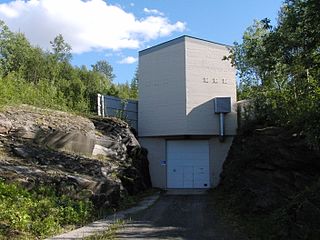
The Daja Hydroelectric Power Station is a hydroelectric power station in the municipality of Fauske in Nordland county, Norway. It is located about 2.3 kilometers (1.4 mi) east-southeast of Jakobsbakken.
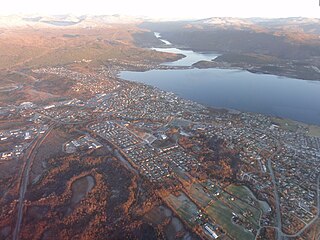
Fauske is a town in Fauske Municipality in Nordland county, Norway. It is also the administrative centre of Fauske Municipality. The town is located on the shore of the Skjerstad Fjord, about 60 kilometres (37 mi) east of the town of Bodø and about 40 kilometres (25 mi) west of the border with Sweden. The lake Nervatnet lies on the southeast side of the town.

Sulitjelma Mines was a Norwegian mining company that extracted copper, pyrite, and zinc at Sulitjelma in the municipality of Fauske, Norway. Operations started with a test mine in 1887. From 1891 to 1933, the business was registered as a Swedish company called Sulitelma Aktiebolags Gruber. From 1933 to 1983, it was registered as a Norwegian company called A/S Sulitjelma Gruber, and from 1983 until it was shut down in 1991 the company was state-owned and was named Sulitjelma Bergverk AS.
